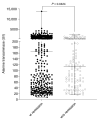Characteristics and Long-Term Outcome of 535 Patients with Autoimmune Hepatitis-The 20-Year Experience of a High-Volume Tertiary Center
- PMID: 37445225
- PMCID: PMC10342368
- DOI: 10.3390/jcm12134192
Characteristics and Long-Term Outcome of 535 Patients with Autoimmune Hepatitis-The 20-Year Experience of a High-Volume Tertiary Center
Abstract
Background and aims: Autoimmune hepatitis (AIH) is a complex and progressive inflammatory liver disease characterized by immune-mediated destruction of the liver parenchyma, hypergammaglobulinemia, the presence of circulating autoantibodies, and good response to immunosuppressive therapy. Since the prevalence of AIH is relatively rare, data on the clinical course and the long-term outcome are scarce. Patients and methods: We retrospectively analyzed the data of 535 well-documented AIH patients treated at the University Hospital Essen between 2000 and 2020. Results: The majority of patients were middle-aged females (75% women, mean age 45 years) with AIH type 1 (97%). Approximately 32% of patients were diagnosed with cirrhosis due to AIH, 29% had concomitant autoimmune (predominantly autoimmune thyroiditis), and 10% had psychiatric diseases, respectively. Skin tumors were the most common malignant diseases (47% of all tumors), while hepatocellular carcinoma rarely occurred (only six cases). Overall long-term mortality and liver-associated mortality were 9.16% and 4.67%, respectively. However, long-term survival was strongly associated with disease remission. Conclusions: Although AIH is a silent disease and cirrhosis is present in many cases, a favorable long-term prognosis can be achieved by consequent immunosuppressive therapy. The incidence of (liver-associated) complications seems to be lower in comparison to other etiologies, such as viral hepatitis or NASH, and mainly depends on the long-term side effects of immunosuppressive therapy.
Keywords: autoimmune hepatitis; immunosuppression; liver transplantation.
Conflict of interest statement
All authors have nothing to declare.
Figures




Similar articles
-
[Autoimmune liver diseases and their overlap syndromes].Praxis (Bern 1994). 2006 Sep 6;95(36):1363-81. doi: 10.1024/1661-8157.95.36.1363. Praxis (Bern 1994). 2006. PMID: 16989180 Review. German.
-
Autoimmune hepatitis.J Hepatol. 2000;32(1 Suppl):181-97. doi: 10.1016/s0168-8278(00)80425-0. J Hepatol. 2000. PMID: 10728804 Review.
-
[Autoimmune hepatitis and overlap syndrome: diagnosis].Praxis (Bern 1994). 2002 Aug 21;91(34):1339-46. doi: 10.1024/0369-8394.91.34.1339. Praxis (Bern 1994). 2002. PMID: 12233264 Review. German.
-
Autoimmune hepatitis in India: single tertiary referral centre experience.Trop Gastroenterol. 2015 Jan-Mar;36(1):36-45. doi: 10.7869/tg.243. Trop Gastroenterol. 2015. PMID: 26591953
-
Autoimmune diseases of the liver and biliary tract and overlap syndromes in childhood.Minerva Gastroenterol Dietol. 2009 Mar;55(1):53-70. Minerva Gastroenterol Dietol. 2009. PMID: 19212308 Review.
Cited by
-
Long-term outcomes of patients with autoimmune hepatitis induced cirrhosis after immunosuppressive treatment.Eur J Gastroenterol Hepatol. 2024 Jun 1;36(6):742-749. doi: 10.1097/MEG.0000000000002714. Epub 2024 Mar 28. Eur J Gastroenterol Hepatol. 2024. PMID: 38555597 Free PMC article.
-
Prevention in Hepatology.J Pers Med. 2024 Jan 23;14(2):132. doi: 10.3390/jpm14020132. J Pers Med. 2024. PMID: 38392566 Free PMC article. Review.
References
-
- van Gerven N.M., Verwer B.J., Witte B.I., van Erpecum K.J., van Buuren H.R., Maijers I., Visscher A.P., Verschuren E.C., van Hoek B., Coenraad M.J., et al. Epidemiology and clinical characteristics of autoimmune hepatitis in the Netherlands. Scand. J. Gastroenterol. 2014;49:1245–1254. doi: 10.3109/00365521.2014.946083. - DOI - PubMed
LinkOut - more resources
Full Text Sources

